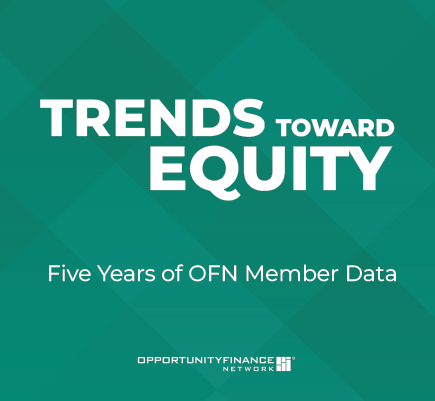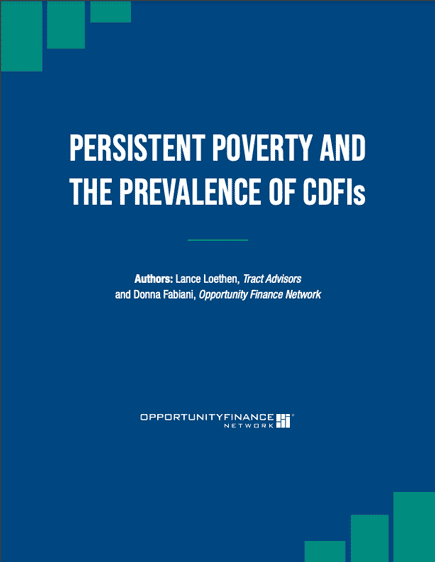CDFI Resource Library
Overview
Opportunity Finance Network (OFN) reports, surveys, training resources, and other publications provide valuable data and insight on the community development financial institution (CDFI) industry.
OFN members receive discounts on premium publications. Contact Roland Kamara for more information.
Featured Publications

Opportunity Finance Institutions: Side by Side, 26th Edition
April 2025
Side by Side is an annual reference guide for industry practitioners, investors, and others interested in assessing the activity and performance of the opportunity finance industry. It presents data from CDFIs in the OFN membership and includes peer group analyses for the primary financing sectors.

Inside the Membership: Statistical Highlights from OFN Membership, Fiscal Year 2023
April 2025
This fact sheet provides information on the 470+ CDFIs in the OFN membership.

The Business Model of CDFI Loan Funds
February 2025
A first-of-its-kind research publication offering a deep dive into CDFI loan funds. The study, based on interviews with 15 CDFI loan fund leaders from 13 states, examines how loan funds operate and create value for their customers. It offers valuable insights to help stakeholders — funders, policymakers, and investors — better understand this essential model for rural, urban, and Native community investment and transformation.
A condensed version of the paper is also available for download. Access the two-pager.

CDFI Survey Findings on Output and Outcome Tracking
April 2024
A brief from the Richmond Fed and OFN looks at several of the Federal Reserve’s 2023 CDFI Survey findings on how and why CDFIs measure outputs and outcomes. It aims to understand what output and outcome metrics CDFIs measure and want to measure, why CDFIs track metrics, and what challenges they face in tracking metrics.

Opportunity Finance Institutions: Side by Side, 25th Edition
January 2024
Side by Side is an annual reference guide for industry practitioners, investors, and others interested in assessing the activity and performance of the opportunity finance industry. It presents data from 368 CDFIs in the OFN membership and includes peer group analyses for the primary financing sectors.

Inside the Membership: Statistical Highlights from OFN Membership, Fiscal Year 2022
January 2024
This fact sheet provides information on as many as 368 CDFIs in the OFN membership, depending on the data point.

A View of PPP from the Inside: Financing, Financial Performance, and Operations of CDFI Paycheck Protection Program Lenders
December 2023
This brief examines the financing activity, financial performance, and efficiency and operations of Opportunity Finance Network’s member CDFIs that served as Paycheck Protection Program (PPP) lenders. These members devoted a substantial portion of their fiscal year 2021 lending activity to PPP, had higher self-sufficiency and change in net assets than non-PPP lenders, and achieved high rates of operational efficiency.

Five Research Priorities for Community Development Financial Institutions: Advancing Financial Inclusion Through Evidence-based Practice
November 2023
CDFIs have a shared vision of a more inclusive financial system, but CDFIs and their stakeholders differ on how to best track progress. To foster more alignment, this paper outlines a proposed research agenda — mainly from the perspective of CDFI loan funds — to facilitate a better understanding of how CDFIs contribute to the nation’s financial inclusion ecosystem.
Download the paper:

CDFI Loan Fund Compensation Survey
Data in effect — April 1, 2023
The 2023 CDFI Loan Fund Compensation Survey Report is a valuable resource that can help CDFIs recruit, reward, and retain high-quality employees. The report is a comprehensive examination of CDFI loan fund compensation data from 154 CDFIs across the country. For CDFIs that are in expansion mode or those now budgeting for 2024, this report will be helpful in setting compensation levels for new positions.

Trends Toward Equity: Five Years of OFN Member Data
March 2023
Given changes in the community development financial institution (CDFI) industry and broader economic context, this brief examines CDFI activity, performance, and outcomes among all OFN members from 2017 through 2021. Where appropriate, for additional insights, we restrict the sample to members that have consistently reported data for the last five years.

Persistent Poverty and the Prevalence of CDFIs
In new research supported by the Robert Wood Johnson Foundation, Opportunity Finance Network shows the traditional measure of persistent poverty by county severely undercounts the number of Americans living in entrenched poverty and is less geographically inclusive of rural and urban communities alike.
The paper posits that measuring persistent poverty at a census tract level offers a more equitable and accurate methodology and has profound implications for many CDFIs.
A county measure suggests that nearly half of CDFIs have no lending activity in these areas. A census tract measure shows that the vast majority of CDFIs lend in persistent poverty areas and that nearly 40 percent of all CDFI lending is in these areas, a testament to the CDFI industry’s targeting of highly vulnerable rural and urban communities.
Persistent Poverty and the Prevalence of CDFIs offers:
- Foreword by Partners for Rural Transformation
- Data comparison of persistent poverty when measured by census tract and county, including overview of CDFI lending
- Borrower stories and tracking resources
- Recommendations for CDFIs, policymakers, funders, and investors
Featured Training Resources
OFN’s new training resources and tools aim to help CDFI practitioners and partners expand the knowledge and skills they need to achieve the greatest impact in the communities they serve. The toolkits are available for free. To learn more, visit OFN’s training page.

CDFI 101 Orientation
OFN’s CDFI 101 toolkit aims to help practitioners feel better connected to the CDFI industry and the common goals we all share; understand what it means to be a part of the movement built over the past 50 years; and be inspired by the industry’s roots.

Talent Recruitment, Retention & Management
This toolkit aims to assist CDFIs with finding the right people, with the right skills, at the right time for the organization; supporting equitable hiring, retention, and advancement practices; providing insights into staffing trends; and offering actionable examples that make it easy to implement the leading practices shared.

Purpose to Practice: Centering Equity in Lending Practices
This toolkit was developed to help CDFIs incorporate an explicit focus on equity, inclusion, and accessibility into their lending practices. You’ll find a guide structured in four sections, each with suggested actions and activities you can undertake individually or as a group.

More OFN Resources and Publications
To find and download other OFN resources and publications, visit CDFI Connect, a digital space for OFN members, allies, funders, investors and other CDFI industry supporters to network, collaborate, and learn.